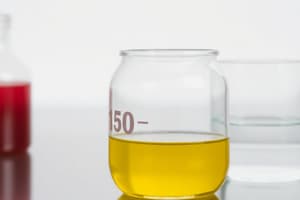Podcast
Questions and Answers
Which of the following is NOT a subatomic particle?
Which of the following is NOT a subatomic particle?
- Proton
- Neutron
- Electron
- Molecule (correct)
Which of the following is a natural element?
Which of the following is a natural element?
- Arsenic (correct)
- Technetium
- Curium
- Plutonium
What is the difference between a compound and a mixture?
What is the difference between a compound and a mixture?
- A compound can be separated into its constituent atoms by simple methods, while a mixture cannot (correct)
- A compound is a combination of two or more substances, while a mixture contains only one substance
- A compound retains its own chemical identity when combined with another substance, while a mixture does not
- A compound is made up of only one type of atom, while a mixture is made up of different types of atoms
What is the maximum number of electrons that can be accommodated in the outermost orbit of an atom?
What is the maximum number of electrons that can be accommodated in the outermost orbit of an atom?
Who discovered the neutron?
Who discovered the neutron?
What is the difference between isotopes and isobars?
What is the difference between isotopes and isobars?
Which scientist proposed the idea of electrons moving in fixed paths around the nucleus in their atomic model?
Which scientist proposed the idea of electrons moving in fixed paths around the nucleus in their atomic model?
What is the formula for calculating the number of neutrons in an atom?
What is the formula for calculating the number of neutrons in an atom?
Which of the following elements has a valency of 2?
Which of the following elements has a valency of 2?
Flashcards are hidden until you start studying
Study Notes
Structure of an Atom: Class 9 Science Notes
- An atom contains three fundamental particles: protons, neutrons, and electrons.
- The nucleus of an atom contains protons and neutrons, while electrons are located in the outermost regions called the electron shell.
- Electrons are discovered in 1897 by J.J. Thomson, protons are discovered in 1886 by Ernest Goldstein, and neutrons are discovered by J. Chadwick.
- Different models of an atom are proposed by scientists, including Thomson's Christmas pudding model, Rutherford's gold foil experiment, and Bohr's model.
- Valency is the tendency of an atom to react with other atoms of the same or various elements, and it is determined by the number of valence electrons in the outermost shell.
- The atomic number is equal to the number of protons present in an atom, and the mass number is the total number of protons and neutrons.
- Isotopes are atoms of the same element with different mass numbers, while isobars are atoms of different elements with the same mass number.
- The maximum number of electrons present in a shell is determined by the formula 2n^2, where n is the orbit number.
- The maximum number of electrons that can be accommodated in the outermost orbit is 8.
- The valency of an atom becomes zero when the outermost shell has eight electrons or no electrons to lose.
- Examples of atoms and their structures include carbon (6 protons, 6 electrons, and 6 neutrons), oxygen (8 protons, 8 electrons, and 8 neutrons), and hydrogen (1 proton, 1 electron, and no neutrons).
- To write the distribution of electrons in various shells for the first eighteen elements, the maximum number of electrons in different shells can be calculated using the formula 2n^2.
Important Questions and Answers on Structure of the Atom for Class 9 Chemistry
- The provided questions and answers are based on the CBSE board curriculum for Class 9 chemistry syllabus.
- Practising these important questions will help students to review all the concepts covered in the chapter and prepare for annual examinations.
- The PDF for Class 9 Chemistry Chapter 4 – Structure of the Atom Important Questions with Answers is available for download by clicking on the provided button.
- The short answer type questions cover topics such as atomic structure, valency, electron distribution, isotopes, and the contributions of scientists like Rutherford and Thomson.
- The long answer type questions cover topics such as the drawbacks of Rutherford's model, the postulates of Bohr's model, and the conclusions drawn from Rutherford's α-ray scattering experiment.
- The MCQs at the end of the text cover topics such as the discovery of the electron, valency, and radioactive elements.
- The provided text also includes examples of electron configurations for different elements, and the valency of noble gases being zero due to their stable electron configuration.
- The text also explains how isotopes have the same atomic number but different mass numbers, and how the number of protons is never greater than the number of neutrons in an atom.
- The text provides a formula for calculating the number of neutrons in an atom based on its mass number and atomic number.
- The postulates of Bohr's model include electrons moving in fixed paths around the nucleus, varying energy levels of shells, and quantized angular momentum.
- The provided text includes a calculation for the number of α-particles that would deflect at angles less than 50° in the Gold foil experiment.
- The text also includes a table for completing the atomic symbol based on the number of protons and neutrons present in the nucleus.
Studying That Suits You
Use AI to generate personalized quizzes and flashcards to suit your learning preferences.




